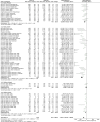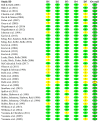Impact of energy density on energy intake in children and adults: a systematic review and meta-analysis of randomized controlled trials
- PMID: 36460778
- PMCID: PMC10030411
- DOI: 10.1007/s00394-022-03054-z
Impact of energy density on energy intake in children and adults: a systematic review and meta-analysis of randomized controlled trials
Abstract
Purpose: The energy density (ED) of a diet can be leveraged to prevent weight gain or treat overweight and obesity. By lowering the ED of the diet, energy intake can be reduced while maintaining portion size. However, a reliable meta-analysis of data from randomized controlled trials (RCTs) is missing. Therefore, this meta-analysis synthesized the evidence of ED manipulation on energy intake in RCTs.
Methods: The systematic literature search of multiple databases according to PRISMA criteria considered RCTs investigating the objectively measured energy intake from meals with different ED (lower ED (median 1.1 kcal/g) versus higher ED (median 1.5 kcal/g)) under controlled conditions. Subgroup analyses for age (children versus adults), meal type (preload versus entrée design), and intervention length (1 meal versus > 1 meal) were performed to achieve the most homogeneous result.
Results: The meta-analysis of 38 included studies demonstrated that lowering ED considerably reduced energy intake - 223 kcal (95% CI: - 259.7, - 186.0) in comparison to the higher ED interventions. As heterogeneity was high among studies, subgroup analyses were conducted. Heterogeneity decreased in subgroup analyses for age and meal type combined, strengthening the results. An extended analysis showed a positive linear relationship between ED and energy intake. Dietary ED did not affect the amount of food intake.
Conclusion: Manipulating ED substantially affects energy intake whereas food intake remains constant. Thus, this approach can be regarded as a powerful tool for weight management through nutrition therapy. Registration on 08/08/2021: CRD42021266653.
Keywords: Diet; Energy density; Energy intake; Manipulation; Nutrition; Obesity.
© 2022. The Author(s).
Conflict of interest statement
The authors declare no conflict of interest. The funders had no role in the design of the study, in the collection, analyses or interpretation of data, in the writing of the manuscript, or in the decision to publish the results.
Figures







Similar articles
-
Nutritional labelling for healthier food or non-alcoholic drink purchasing and consumption.Cochrane Database Syst Rev. 2018 Feb 27;2(2):CD009315. doi: 10.1002/14651858.CD009315.pub2. Cochrane Database Syst Rev. 2018. PMID: 29482264 Free PMC article.
-
Effects of a gluten-reduced or gluten-free diet for the primary prevention of cardiovascular disease.Cochrane Database Syst Rev. 2022 Feb 24;2(2):CD013556. doi: 10.1002/14651858.CD013556.pub2. Cochrane Database Syst Rev. 2022. PMID: 35199850 Free PMC article.
-
Effects of total fat intake on bodyweight in children.Cochrane Database Syst Rev. 2018 Jul 5;7(7):CD012960. doi: 10.1002/14651858.CD012960.pub2. Cochrane Database Syst Rev. 2018. PMID: 29974953 Free PMC article.
-
Enteral nutritional therapy for induction of remission in Crohn's disease.Cochrane Database Syst Rev. 2018 Apr 1;4(4):CD000542. doi: 10.1002/14651858.CD000542.pub3. Cochrane Database Syst Rev. 2018. PMID: 29607496 Free PMC article.
-
Effects of total fat intake on bodyweight in children.Cochrane Database Syst Rev. 2018 Feb 15;2(2):CD012960. doi: 10.1002/14651858.CD012960. Cochrane Database Syst Rev. 2018. Update in: Cochrane Database Syst Rev. 2018 Jul 05;7:CD012960. doi: 10.1002/14651858.CD012960.pub2. PMID: 29446437 Free PMC article. Updated.
Cited by
-
Nutrients or processing? An analysis of food and drink items from the UK National Diet and Nutrition Survey based on nutrient content, the NOVA classification and front of package traffic light labelling.Br J Nutr. 2024 May 14;131(9):1619-1632. doi: 10.1017/S0007114524000096. Epub 2024 Jan 15. Br J Nutr. 2024. PMID: 38220223 Free PMC article.
-
Making Sense of the Relationship Between Ultra-Processed Foods, Obesity, and Other Chronic Diseases.Nutrients. 2024 Nov 26;16(23):4039. doi: 10.3390/nu16234039. Nutrients. 2024. PMID: 39683433 Free PMC article. Review.
-
Food intake and eating behaviour during a real-life Snack Scenario in childhood obesity-An experiment using a hidden camera.Eur Eat Disord Rev. 2025 Jan;33(1):67-79. doi: 10.1002/erv.3130. Epub 2024 Aug 9. Eur Eat Disord Rev. 2025. PMID: 39123316 Free PMC article.
-
Sweetness preference and its impact on energy intake and body weight - a review of evidence.Front Nutr. 2023 Oct 18;10:1289028. doi: 10.3389/fnut.2023.1289028. eCollection 2023. Front Nutr. 2023. PMID: 37927507 Free PMC article. Review.
-
Children's Energy Intake Generally Increases in Response to the Energy Density of Meals but Varies with the Amounts and Types of Foods Served.Am J Clin Nutr. 2024 Jan;119(1):185-195. doi: 10.1016/j.ajcnut.2023.10.019. Epub 2023 Oct 27. Am J Clin Nutr. 2024. PMID: 37890673 Free PMC article.
References
Publication types
MeSH terms
Grants and funding
LinkOut - more resources
Full Text Sources
Research Materials

